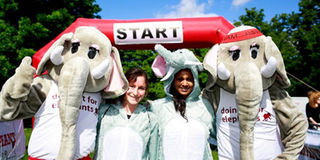My 10km run to save the elephant

Runners in elephant suits in Clapham Common, London. PHOTO | COURTESY
What you need to know:
- It also set a world record in the process — for the biggest gathering of people dressed as elephants (297). It would be good to see a similar event in Kenya, though the prospect of running 10km in an elephant suit in 30 degree heat is slightly less appealing.
- The DSWT clearly plays an important role in raising awareness of the plight of elephants, particularly in the UK and the US, where a surprisingly high volume of illegal ivory is sold.
- The US is actually the world’s second largest retail market for elephant ivory products, behind only China, and fails to comply with its own national laws and CITES regulations.
- Curbing the demand for ivory is equally, if not more, important than cutting off its supply, which accentuates the value of the DSWT’s work abroad.
You often see weird and wonderful things on “the Tube” – the underground rail network that weaves beneath London’s bustling streets.
This subterranean world is no stranger to groups of people in outlandish outfits and elaborate costumes, particularly late on a Friday night.
I tried to bear this in mind last weekend as I sat in a busy train reading the newspaper dressed as an elephant. It was 9 o’clock in the morning though, so I felt far less inconspicuous.
I was on my way to Clapham Common, a large urban park in the south of the city for “The Enormous Elephant Run”, an annual event organised by the David Sheldrick Wildlife Trust (DSWT).
Every year, hundreds of people in elephant costumes flood one of the city’s parks and run either 5km or 10km to raise money for the Trust’s conservation work in Kenya.
The event will also be held in Manchester in July, and more adventurous fundraisers can take part in a series of “Tough Mudders” across the UK — where participants have to conquer a daunting 20km obstacle course.
ELEPHANT SUITS
I chose to do the 10km run, which isn’t easy at the best of times, let alone in a grey “onesie” with a set of tusks and a trunk bobbing about above your head. The course meandered through the park, alongside its ponds and playgrounds with excited children pointing at us and screaming: “Look at all the rabbits!” I suppose elephants are a rare sight in Clapham, and we did look a bit like rabbits.
We also ran past dozens of volunteers in high-visibility jackets guiding us in the right direction, which reflected both the commitment of those involved to the cause and the fact that the DSWT’s London office is a relatively small outfit.
I first realised this when I attended another of their events in London earlier this year: a screening at the Royal Geographical Society of “Gardeners of Eden”, a compelling film about the DSWT and its efforts to save Kenya’s elephants from the burgeoning ivory trade.
The event was hosted by the film’s executive producer and renowned actress Kristin Davis, as well as Trustee Robert Carr-Hartley and the DSWT’s UK Director Rob Brandford. In the Q&A session after the film, they emphasised how small the UK team was, and that Kristin too found herself dealing with some of its administrative tasks.
The fact that the Trust’s UK-based fundraising initiatives are coordinated by such a small core group is extremely impressive, even more so in light of their success. This year’s Enormous Elephant Run has so far raised a massive £44,000 (about Sh6.3m).
It also set a world record in the process — for the biggest gathering of people dressed as elephants (297). It would be good to see a similar event in Kenya, though the prospect of running 10km in an elephant suit in 30 degree heat is slightly less appealing.
The DSWT clearly plays an important role in raising awareness of the plight of elephants, particularly in the UK and the US, where a surprisingly high volume of illegal ivory is sold. The US is actually the world’s second largest retail market for elephant ivory products, behind only China, and fails to comply with its own national laws and CITES regulations.
Curbing the demand for ivory is equally, if not more, important than cutting off its supply, which accentuates the value of the DSWT’s work abroad.
ORPHAN PROJECT
Encouragingly, efforts to raise awareness of Africa’s dwindling elephant population seem to be gaining traction in the UK – illustrated by increased media attention and influenced to a large extent by recent royal and celebrity endorsements, most notably Prince William and comedian Ricky Gervais.
A significant element of the DSWT’s popularity, both abroad and in Kenya, is its highly successful orphan-elephant rescue and rehabilitation initiative. So far, the Trust has managed to hand-rear over 150 infant elephants, many of which have been reintegrated back into the wild herds of Tsavo.
This fostering programme has made it extremely easy for people all over the world to adopt Sheldrick’s many orphans, and follow their progress through detailed monthly newsletters. The orphan project lies at the heart of a broader conservation programme that receives far less attention than it deserves. The DSWT also works to protect Kenya’s wildlife and habitats through an anti-poaching unit and a veterinary support unit, and also aims to enhance community awareness and address animal welfare issues.
The Trust funds and operates eight full-time anti-poaching and de-snaring units that patrol the boundaries of the Tsavo conservation area, working in tandem with an aerial surveillance team and a mobile veterinary unit to locate and treat elephants injured by poaching or bush-meat snaring.
For more information on the work of the DSWT visit the orphanage at the Nairobi National Park, or online at: www.sheldrickwildlifetrust.org/, and for information about fundraising initiatives in the UK visit https://runforelephants.com/.





